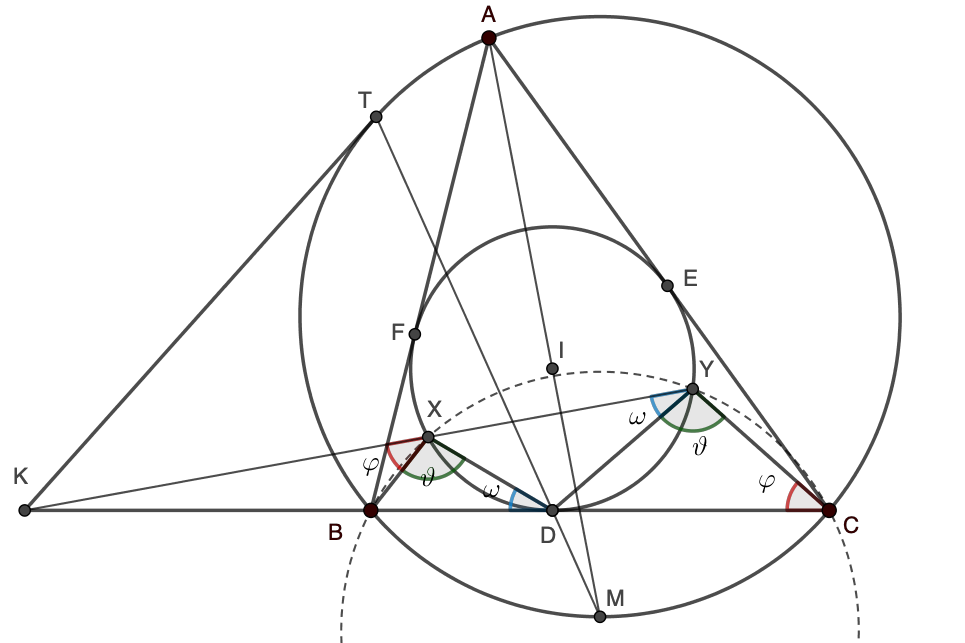Problem 2. Let ABC be a triangle with AC > AB , and denote its circumcircle by Ω and incentre by I . Let its incircle meet sides BC, CA, AB at D, E, F respectively. Let X and Y be two points on minor arcs and of the incircle, respectively, such that ∠ BXD = ∠ DYC . Let line XY meet line BC at K . Let T be the point on Ω such that KT is tangent to Ω and T is on the same side of line BC as A . Prove that lines TD and AI meet on Ω.
Solution 1
Invert about a circle centred at  with radius
with radius  , followed by a flip about
, followed by a flip about  . The incircle is sent to a parallel line to
. The incircle is sent to a parallel line to  , and
, and  is fixed by Power of a Point. Now the angle condition is reformulated as
is fixed by Power of a Point. Now the angle condition is reformulated as  , but since
, but since  lie on a parallel line to
lie on a parallel line to  ,
,  is an isosceles trapezium.
is an isosceles trapezium.
Now as the center of  lies on the perpendicular bisector of
lies on the perpendicular bisector of  as it is a chord, by symmetry
as it is a chord, by symmetry  is the reflection of
is the reflection of  about the midpoint of
about the midpoint of  . In fact,
. In fact,  being tangent to
being tangent to  , implies
, implies  is the arc midpoint of
is the arc midpoint of  as the tangency point is fixed about a reflection across the perpendicular bisector of
as the tangency point is fixed about a reflection across the perpendicular bisector of  (Else we would have two intersection points of
(Else we would have two intersection points of  with
with  ), and
), and  swap under this reflection.
swap under this reflection.
In fact as  is fixed
is fixed  , but as it is the arc midpoint by the Incenter-Excenter Lemma
, but as it is the arc midpoint by the Incenter-Excenter Lemma  are collinear and we are done,
are collinear and we are done,

Solution 2
Let  ,
,  , and
, and  .
.
We first note that quadrilateral  is cyclic, since
is cyclic, since  . So, also let
. So, also let  .
.
Since  is tangent to the incircle of
is tangent to the incircle of  and
and  is tangent to
is tangent to  at
at  , from the power of point theorem we get
, from the power of point theorem we get
![\[
KD^2=KX\cdot KY=KB\cdot KC=KT^2,
\]](https://latex.artofproblemsolving.com/9/3/e/93eb5156012ece3a97d00118bab47a8c7b8b8c94.png) and so
and so  .
.
From triangles  and
and  we have
we have
![\[
\frac{KX}{XD}=\frac{\sin\omega}{\sin k}. \quad \text{and}\quad \frac{KY}{YC}=\frac{\sin \varphi}{\sin k}.
\]](https://latex.artofproblemsolving.com/7/9/b/79bd856db967c072c14ddea32b68d1a547012947.png) By the ratio lemma, we have
By the ratio lemma, we have
![\[
\frac{KB}{BD}=\frac{KX}{XD}\cdot \frac{\sin \varphi}{\sin \theta}=\frac{\sin\omega}{\sin k}\cdot \frac{\sin \varphi}{\sin \theta}
\]](https://latex.artofproblemsolving.com/b/0/b/b0bd5afc59f57038a2267d32be430df0c5344c01.png) and
and
![\[
\frac{KD}{DC}=\frac{KY}{YC}\cdot \frac{\sin \omega}{\sin \theta}=\frac{\sin \varphi}{\sin k}\cdot \frac{\sin \omega}{\sin \theta}
\]](https://latex.artofproblemsolving.com/6/5/e/65e4e2cd70fb90f9b6fbb2345a5bbe4e9f692617.png) Hence
Hence  , and so,
, and so,
![\[
\frac{KD}{KB}=\frac{DC}{BD}.
\]](https://latex.artofproblemsolving.com/5/8/3/583b7fc838a12b99b062336936a7536565cad9f8.png)
Also, triangles  and
and  are similar, since
are similar, since  , so
, so
![\[
\frac{TC}{TB}=\frac{KT}{KB}=\frac{KD}{KB}=\frac{DC}{BD}.
\]](https://latex.artofproblemsolving.com/b/0/3/b033f2cd5da1f499c2e76320f9092611cff00620.png) Therefore,
Therefore,  bisects angle
bisects angle  , and so
, and so  and
and  , as the angle bisector of
, as the angle bisector of  , meet at the midpoint
, meet at the midpoint  of arc
of arc  .
.


